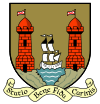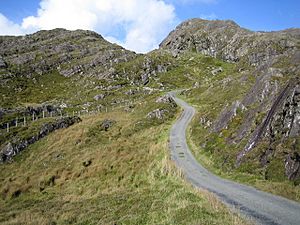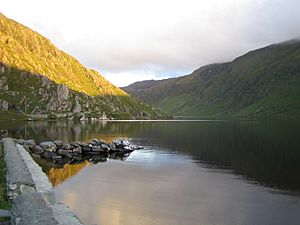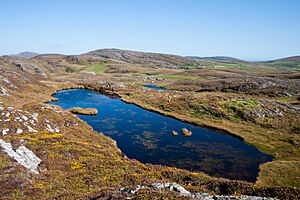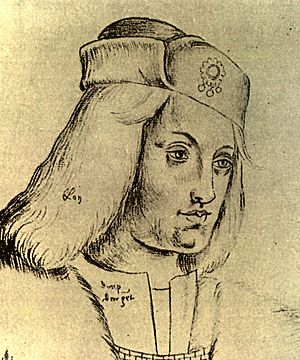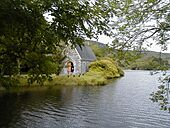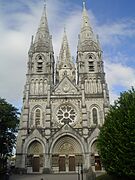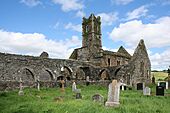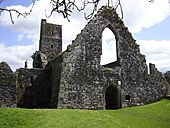County Cork facts for kids
Quick facts for kids
County Cork
Contae Chorcaí
|
||
|---|---|---|
|
||
| Nickname(s):
The Rebel County
|
||
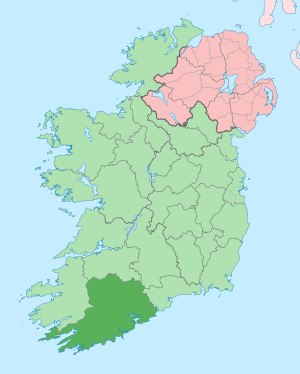 |
||
| Country | Ireland | |
| Province | Munster | |
| Region | Southern | |
| Established | 1606 | |
| County town | Cork | |
| Area
(incl. city)
|
||
| • Total | 7,508 km2 (2,899 sq mi) | |
| Area rank | 1st | |
| Highest elevation
(Knockboy)
|
706 m (2,316 ft) | |
| Population
(2022)
|
||
| • Total | 584,156 | |
| • Rank | 3rd | |
| • Density | 77.804/km2 (201.513/sq mi) | |
| Demonym(s) | Corkonian | |
| Time zone | UTC±0 (WET) | |
| • Summer (DST) | UTC+1 (IST) | |
| Eircode routing keys |
P12, P14, P17, P24, P25, P31, P32, P36, P43, P47, P51, P56, P61, P67, P72, P75, P81, P85, T12, T23, T34, T45, T56 (primarily)
|
|
| Telephone area codes | 02x, 063 (primarily) | |

County Cork (Irish: Contae Chorcaí) is the largest and most southern county in Ireland. It is named after Cork City, which is the second-largest city in the country. County Cork is part of the Munster province and the Southern Region.
Some of its biggest towns are Mallow, Macroom, Midleton, and Skibbereen. In 2022, about 584,156 people lived in County Cork. This makes it the third most populated county in Ireland. The Cork County Council manages the county, while the Cork City Council looks after Cork City.
County Cork is known as the "Rebel County." King Henry VII of England gave it this name because people in Cork supported Perkin Warbeck in 1491. He claimed to be a prince and tried to take over the throne.
Cork shares borders with four other counties: Kerry to the west, Limerick to the north, Tipperary to the northeast, and Waterford to the east. The southwest part of Cork, called West Cork, is a popular place for tourists. It has a beautiful coastline and ancient stone monuments.
University College Cork, founded in 1845, is a large university here. Around 22,000 students attend it. Important companies in Cork include Dell EMC, Apple's European office, and Dairygold, a dairy company.
Contents
Exploring County Cork's Geography

County Cork is the biggest county in Ireland by land area. It is also the largest of Munster's six counties by population and size. In 2022, the county had a population of 584,156 people. Cork is the second most populated county in the Republic of Ireland.
The county is located in the Munster province. It shares borders with Kerry (west), Limerick (north), Tipperary (northeast), and Waterford (east). The mountains on the borders with Tipperary and Kerry were formed millions of years ago. This happened when Ireland was part of a larger landmass.
The landscape of Cork has peaks and valleys. These were shaped by ancient mountain-building events about 300 million years ago. The county has 24 historic areas called baronies. These are old divisions, but they are not used for many official tasks anymore. There are also 253 civil parishes and about 5,447 small areas called townlands.
Mountains and Upland Areas in Cork
Cork's mountains were formed between 374 and 360 million years ago. These include the Slieve Miskish and Caha Mountains on the Beara Peninsula. You can also find the Ballyhoura Mountains near the Limerick border. The Shehy Mountains are on the border with Kerry.
Knockboy is the highest point in Cork, standing at 706 meters. Other mountain ranges are the Boggeragh, Derrynasaggart, and Mullaghareirk. These upland areas have important natural habitats. These include blanket bogs, heathlands, and glacial lakes. Cork has the 13th highest county peak in Ireland.
Rivers and Lakes of County Cork
Three main rivers flow through central Cork: the Bandon, Blackwater, and Lee. Their valleys and floodplains have woodlands, marshes, and rich grasslands. The River Bandon flows through towns like Dunmanway and Bandon. It then empties into Kinsale Harbour.
Cork also has sea loughs like Lough Hyne and Lough Mahon. There are many small lakes too. Near Cork City, the River Lee forms a network of channels and wooded islands. This creates a large swampland area.
Land and Forests in Cork
County Cork has very fertile farming land. It also has many bog and peatland areas. About 9.8% of the county's land is peatland. Cork has the largest share of forests in Ireland. There are around 90,020 hectares of forest and woodland. This makes up about 12% of Cork's land area. It is home to some of the last native woodlands in Ireland and Europe.

Wildlife in County Cork
The hooded crow is a common bird, especially near the coast. The coastline of Cork is a great place to spot rare birds. Cape Clear Island is a top spot for bird watching. It also has one of the few gannet colonies in Ireland.
The Cork coastline is also known for whale watching. You might see fin whales, basking sharks, minke whales, and other species here.
Cork's Coastline and Islands
Cork has a mix of mountains and flat land, with many beaches and sea cliffs. The southwest of Ireland is famous for its peninsulas. In Cork, these include the Beara Peninsula, Sheep's Head, Mizen Head, and Brow Head. Brow Head is the most southerly point of mainland Ireland.
Many islands are off the coast of Cork, especially in West Cork. The "Carbery's Hundred Isles" are found around Long Island Bay. Fastnet Rock is 11.3 km south of mainland Ireland. This makes it the most southerly point of Ireland. Other important islands include Bere, Great Island, Sherkin, and Cape Clear.
Cork has about 1,199 km of coastline. It is one of three counties that claim to have the longest coastline in Ireland. Cork also borders two bodies of water: the Celtic Sea to the south and the Atlantic Ocean to the west.
| Cork Harbour (Celtic Sea) | Jan | Feb | Mar | Apr | May | Jun | Jul | Aug | Sep | Oct | Nov | Dec | Year |
|---|---|---|---|---|---|---|---|---|---|---|---|---|---|
| Sea Temperature | 11.4 °C (52.5 °F) | 10.7 °C (51.3 °F) | 10.5 °C (50.9 °F) | 12.2 °C (54.0 °F) | 12.9 °C (55.2 °F) | 15.8 °C (60.4 °F) | 18.1 °C (64.6 °F) | 17.9 °C (64.2 °F) | 17.4 °C (63.3 °F) | 16.0 °C (60.8 °F) | 13.7 °C (56.7 °F) | 12.3 °C (54.1 °F) | 14.1 °C (57.4 °F) |
| Bantry (Atlantic Ocean) | Jan | Feb | Mar | Apr | May | Jun | Jul | Aug | Sep | Oct | Nov | Dec | Year |
| Sea Temperature | 11.6 °C (52.9 °F) | 11.2 °C (52.2 °F) | 11.0 °C (51.8 °F) | 12.1 °C (53.8 °F) | 12.8 °C (55.0 °F) | 15.6 °C (60.1 °F) | 17.6 °C (63.7 °F) | 17.5 °C (63.5 °F) | 17.3 °C (63.1 °F) | 15.8 °C (60.4 °F) | 13.8 °C (56.8 °F) | 12.2 °C (54.0 °F) | 14.0 °C (57.2 °F) |
A Brief History of County Cork
| Historical population | ||
|---|---|---|
| Year | Pop. | ±% |
| 1600 | 21,889 | — |
| 1610 | 34,250 | +56.5% |
| 1653 | 54,250 | +58.4% |
| 1659 | 63,031 | +16.2% |
| 1821 | 730,444 | +1058.9% |
| 1831 | 810,732 | +11.0% |
| 1841 | 854,118 | +5.4% |
| 1851 | 649,308 | −24.0% |
| 1861 | 544,818 | −16.1% |
| 1871 | 517,076 | −5.1% |
| 1881 | 495,607 | −4.2% |
| 1891 | 438,432 | −11.5% |
| 1901 | 404,611 | −7.7% |
| 1911 | 392,104 | −3.1% |
| 1926 | 365,747 | −6.7% |
| 1936 | 355,957 | −2.7% |
| 1946 | 343,668 | −3.5% |
| 1951 | 341,284 | −0.7% |
| 1956 | 336,663 | −1.4% |
| 1961 | 330,443 | −1.8% |
| 1966 | 339,703 | +2.8% |
| 1971 | 352,883 | +3.9% |
| 1979 | 396,118 | +12.3% |
| 1981 | 402,465 | +1.6% |
| 1986 | 412,735 | +2.6% |
| 1991 | 410,369 | −0.6% |
| 1996 | 420,510 | +2.5% |
| 2002 | 447,829 | +6.5% |
| 2006 | 481,295 | +7.5% |
| 2011 | 519,032 | +7.8% |
| 2016 | 542,868 | +4.6% |
| 2022 | 584,156 | +7.6% |
County Cork is often called "The Rebel County." This name comes from events in the 15th century. However, it is more commonly linked to Cork's important role in the Irish War of Independence (1919–1921). During this time, there was a lot of fighting in Cork. It was also a strong area for those against the Anglo-Irish Treaty during the Irish Civil War (1922–23).
Much of what is now County Cork was once part of the Kingdom of Desmond. This kingdom was ruled by the MacCarthy Mór family. After the Normans invaded in the 12th century, the MacCarthy family moved west. Dunlough Castle, built in 1207, is one of Ireland's oldest castles. The northern and eastern parts of Cork were taken by the FitzGerald family.
In 1491, Cork played a part in the English Wars of the Roses. A man named Perkin Warbeck came to Cork. He claimed to be Richard of Shrewsbury, Duke of York, a missing prince. He tried to get support to overthrow King Henry VII of England. The people of Cork supported Warbeck because he was Flemish, not English. Cork was the only county in Ireland to join his fight. The mayor of Cork and other important citizens went with Warbeck to England. But the rebellion failed, and they were all captured and executed. This is how Cork got its nickname, the 'rebel county'.
In 1601, the important Battle of Kinsale happened in County Cork. Spanish troops landed in Kinsale to help Irish rebels in the Nine Years' War. When these Spanish forces were defeated, the rebels' hopes for victory ended. County Cork was officially created in 1606.
In the early 1600s, the area of Leamcon near Schull was a pirate stronghold. Pirates easily traded in Baltimore and Whiddy Island.

In the 19th century, Cork was a center for Irish nationalist movements. It was a key area for guerrilla fighting during the Irish War of Independence (1919–1921). Three groups of the Irish Republican Army (IRA) operated in the county. Famous actions included the Kilmichael Ambush in November 1920 and the Crossbarry Ambush in March 1921. The movie The Wind That Shakes The Barley shows the actions of IRA groups like the one led by Tom Barry in West Cork. On December 11, 1920, Cork City center was destroyed by fires. These fires were started by the Black and Tans as revenge for IRA attacks. Many other towns and villages in the county, like Fermoy, also suffered.
During the Irish Civil War (1922–23), most IRA units in Cork were against the Anglo-Irish Treaty. From July to August 1922, they controlled the city and county. However, troops from the Irish Free State took Cork in August 1922. This included attacks by land and sea. Fighting continued in the county until May 1923, when the Anti-Treaty side stopped fighting. Michael Collins, a key figure in the War of Independence, was born near Clonakilty. He was killed during the civil war in Béal na Bláth, both in West Cork.
The Irish Language in Cork
County Cork has two Gaeltacht areas. In these areas, the Irish language is the main language spoken every day. These are Múscraí (Muskerry) in the north of the county. This includes villages like Cill Na Martra (Kilnamartyra), Baile Bhúirne (Ballyvourney), Cúil Aodha (Coolea), and Béal Átha an Ghaorthaidh (Ballingeary). The island of Oileán Chléire (Cape Clear Island) is also a Gaeltacht area.
There are about 14,829 Irish speakers in County Cork. Around 3,660 of these are native speakers in the Cork Gaeltacht. In 2011, 6,273 students attended Irish-speaking schools (Gaelscoileanna) and colleges (Gaelcholáistí) across the county. Ballingeary is a center for learning Irish. It has a summer school called Coláiste na Mumhan.
County Cork's Anthem
The song "The Banks of My Own Lovely Lee" is the traditional song for County Cork. You can often hear it played at GAA games and other sports events involving the county.
Media in County Cork
Several newspapers are published in County Cork. These include the Irish Examiner and The Echo. Local newspapers are the Carrigdhoun, Cork Independent, The Corkman, and The Southern Star.
Local radio stations include Cork's 96FM, C103, and Red FM. There are also several community radio stations, such as CRY 104.0FM.
Places to Visit in County Cork
One famous tourist spot is the Blarney Stone at Blarney Castle. If you kiss the stone, it is said to give you the "gift of the gab" (great speaking skills).
The port of Cobh in County Cork was a major departure point for many Irish people. They left Ireland to travel to places like Australia, Canada, and the United States. Cobh was also the last stop for the RMS Titanic before its famous journey.
Fota Wildlife Park, located on Fota Island, is another popular attraction. Nearby, you can find Fota House and Gardens. There is also the Fota Golf Club and Resort. This golf course has hosted the Irish Open several times.
West Cork is known for its beautiful natural scenery, beaches, and friendly atmosphere. It is a popular place for tourists from Britain, Germany, France, and the Netherlands.
-
St Finbar's church, Gougane Barra. A site from the 6th century.
-
Saint Fin Barre's Cathedral, Cork city. Built in 1879 on a 7th-century site.
-
Timoleague Friary, West Cork. Founded in 1240.
-
Kilcrea Friary, mid-Cork. Founded in 1465.
Cork's Economy and Industries
The South-West Region, which includes counties Cork and Kerry, contributed a lot to Ireland's economy in 2020.
The area around Cork Harbour is home to many companies that make medicines and medical products. Mahon Point Shopping Centre is the biggest shopping center in Cork. It has over 75 stores. The Golden Vale is one of the best areas for dairy farming in Ireland. Dairygold, a farmer-owned company, processes a huge amount of milk each year. They turn it into cheeses and milk powders for baby formula.
Population and Demographics
| Leading population centres | ||||||
|---|---|---|---|---|---|---|
| Rank | City/Town | Population (2022) |  Cork  Carrigaline  Cobh |
|||
| 1 | Cork | 224,004 | ||||
| 2 | Carrigaline | 18,239 | ||||
| 3 | Cobh | 14,148 | ||||
| 4 | Midleton | 13,906 | ||||
| 5 | Mallow | 13,456 | ||||
| 6 | Youghal | 8,564 | ||||
| 7 | Bandon | 8,196 | ||||
| 8 | Fermoy | 6,720 | ||||
| 9 | Passage West-Monkstown | 6,051 | ||||
| 10 | Kinsale | 5,991 | ||||
Cork City is the largest urban area in the county. In 2022, it had a population of 224,004 people. Cork is the second most populated city in the Republic of Ireland. According to the 2022 census, the county has 13 towns with over 4,000 people.
In 1841, before the Great Famine, County Cork had a population of 854,118. By the 2022 census, Cork city and county together had 584,156 people.
In 2022, most people in Cork were White Irish (78.5%). Other groups included other White backgrounds (9.9%), Asian (1.4%), and Black (1.1%). The largest religion was Catholicism (71%). About 15.7% of the population said they had no religion.
Transportation in Cork
Cork has good transport links:
- Air: Cork International Airport is the main airport.
- Rail: Iarnród Éireann provides train services. These include long-distance (InterCity) and local (Commuter) trains.
- Sea: The Port of Cork at Cork Harbour handles sea transport.
Famous People from County Cork
Many well-known people come from County Cork. Some common family names in the county include Barry, Buckley, Callaghan, Connell, Connor, Crowley, Lynch, McCarthy, Murphy, O'Leary, O'Sullivan, Sheehan, Walsh, and Fitzgerald. The Fitzgerald name comes from the Normans.
See also
 In Spanish: Condado de Cork para niños
In Spanish: Condado de Cork para niños


